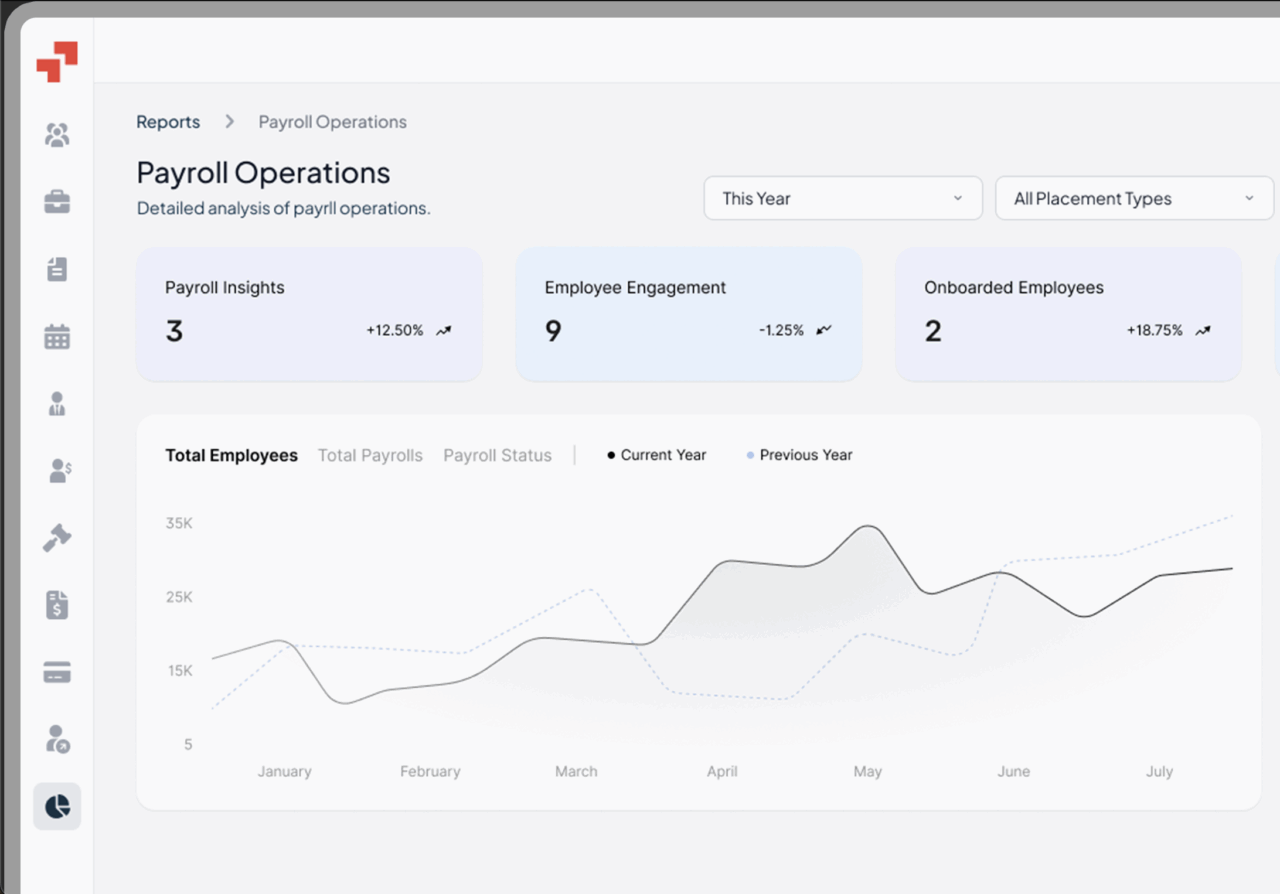Global Workforce GlossaryAccrued Payroll
Accrued payroll refers to wages, salaries, bonuses, commissions, and other compensation earned by employees but not yet paid by the employer.
Accrued payroll describes the total amount of unpaid employee compensation that a business owes, highlighting its significance in financial accounting and liability management. Under accrual accounting, these amounts are recorded as liabilities on the balance sheet until disbursed.
Accrued payroll includes not only regular wages but also bonuses, commissions, paid time off, payroll taxes, and employee benefits, reflecting the comprehensive nature of these liabilities.
Types of Accrued Payroll
Accrued payroll encompasses several categories of employee-related liabilities. Each plays a role in ensuring compliance and accurate reporting:
- Regular Wages and Salaries: Unpaid base pay for hours or days already worked by employees, including gross wages and hourly wage calculations. Gross wages represent the total earnings before deductions, and the hourly wage is used to determine pay for employees based on hours worked.
- Hourly Wages: For employees paid by the hour, businesses must track hourly wages earned but not yet paid, especially when accounting and pay periods do not align.
- Overtime Pay: Additional wages owed under labour laws, often calculated at premium rates (for instance, time-and-a-half in the US).
- Bonuses and Commissions: Earned incentives that haven’t yet been paid, common in sales or performance-driven roles. Accrued salaries are another form of compensation that has been earned but not yet paid.
- Payroll Taxes and Contributions: Employer liabilities such as Social Security and Medicare (US), National Insurance (UK), or pension and social fund contributions (EU). Employer contributions toward these taxes and funds are part of the total accrued payroll liabilities.
- Employee Benefits: Vacation pay, sick leave, or other benefits accrued but unused at period-end. Accrued benefits may include retirement contributions and health insurance, which are important components of employee compensation and financial reporting.
- Miscellaneous Allowances: Travel reimbursements, remote work stipends, or expense claims owed but pending payment.
Recognizing these categories ensures companies adhere to the relevant tax and labour regulations of each jurisdiction and maintain financial integrity.
How To Calculate Accrued Payroll
Accrued payroll is typically calculated by determining what employees have earned up to the reporting date but haven’t yet received. The formula is straightforward but must account for multiple variables:
Accrued Payroll = (Unpaid Wages + Overtime + Bonuses + Benefits) + Employer Payroll Taxes
To calculate it:
- Determine unpaid hours: Multiply hours worked by the employee’s hourly rate.
- Add any earned bonuses or commissions: Include amounts earned but unpaid within the accounting period.
- Include benefits and allowances: Add any prorated benefits or entitlements.
- Add employer taxes and contributions: Reflect all mandatory employer-side liabilities (like payroll tax or National Insurance).
- Calculating accrued payroll: Consider all pay components, including overtime, bonuses, vacation pay, and applicable taxes, to ensure all earned but unpaid amounts are included.
After applying the formula for each employee, sum up the liabilities for all employees to determine the total accrued payroll for the pay period. This total accrued payroll figure is essential for accurate financial statements and compliance.
For US firms, the IRS Publication 15 (Employer’s Tax Guide) outlines required reporting, including compliance with the Federal Insurance Contributions Act (FICA) for social security and employment taxes. UK employers must follow HMRC’s Real Time Information (RTI) reporting, while EU organisations must align with EU Working Time and Payroll Directives.
Accrued payroll example
Example 1 – Weekly Wages: A US marketing firm pays employees every Friday, marking the end of the pay period. By Thursday, employees have earned $5,000 for work already done, but it hasn’t been paid yet. This $5,000 is recorded as accrued wages on the balance sheet until Friday’s payment.
Example 2 – Paid Time Off (PTO): An employee earns 2 vacation days in December but hasn’t used them. The company calculates the daily wage for those 2 days and records the amount as accrued salary, reflecting money owed for earned leave at the end of the pay period.
Example 3 – Bonuses: A company promises a $1,000 year-end bonus. Employees have earned it by December, but the payment is scheduled for January. That $1,000 is recorded as accrued bonuses, ensuring financial statements show all earned compensation for the pay period.
Example 4 – Employer Taxes and Benefits: An employee’s December wages include $3,000 for salary. The company owes $500 in employer taxes and $200 in health benefits. Even if these amounts are paid next month, they are recorded as accrued payroll for accurate accounting.
Why is accrued payroll important?
Accrued payroll represents employee compensation that has been earned but not yet paid. Tracking it properly is critical for companies to maintain accurate financials, plan cash flow, comply with regulations, and make informed business decisions. Here are the key reasons accrued payroll is important:
- Accurate Financial Reporting: Records all earned wages, bonuses, PTO, and benefits in the period they are earned, not just when paid. Provides a true view of liabilities and prevents overstated profits on financial statements. Proper accrual ensures that financial statements accurately reflect the company’s liabilities, including accrued bonuses and payroll taxes.
- Budgeting and Cash Flow Planning: Helps companies anticipate upcoming payroll obligations, including taxes and benefits. Ensures there are enough funds available to pay employees on time and manage cash flow efficiently. Tracking accrued payroll also supports forecast financial planning by improving expense management and financial forecasting.
- Tax Compliance: Aligns payroll reporting with IRS (US), HMRC (UK), and EU regulations. Proper accrual reduces the risk of audit issues and ensures deductions are applied in the correct fiscal period.
- Regulatory Compliance: Supports GAAP, IFRS, and local labour law requirements. Accurate accrued payroll and accrued expenses help companies avoid legal penalties and maintain trustworthy financial records. Payroll accruals play a key role in compliance and contribute to the overall financial health of the organization by ensuring all payroll-related liabilities are properly recorded.
- Employee Trust: Shows employees that all earned compensation, including wages, bonuses, and PTO, is properly tracked. Builds confidence that payments for unpaid compensation will be accurate and timely.
- Strategic Decisions: Provides insights into labor costs by project, team, or region. Enables better budgeting, hiring, payroll management, and planning for expansion or international operations.
For specific compliance or payroll questions, always seek professional legal or tax advice, as this information is general and not a substitute for tailored guidance.
Practical Example of Accrued Payroll
Scenario:A US-based SaaS startup is expanding into Europe, hiring five employees in the UK and five in Germany. December ends on a Sunday, and the company’s payroll is processed on January 5. The total salaries earned in December amount to $75,000, including $5,000 in bonuses and $4,000 in employer taxes.
Accounting Treatment:
- US Compliance: Under IRS and GAAP rules, the startup must record December’s unpaid wages and related taxes as accrued payroll in that month’s financial statements.
- UK Compliance: The UK employees’ December earnings must be reported under HMRC PAYE as part of December’s accounting period, even if payment is in January.
- EU Compliance: In Germany, labour and payroll laws require that employee compensation for December be recognized as an accrued liability for proper tax reporting.
Outcome: By accruing payroll correctly, the startup’s year-end statements accurately reflect liabilities, ensuring investor confidence and audit readiness. Efficient payroll processes are essential for handling multi-country payroll accruals, simplifying complex tasks and ensuring compliance across jurisdictions. Failing to record this accrual could understate expenses by $75,000, distort profit margins, and create reconciliation issues. Using an Employer of Record (EOR) like PamGro ensures these multi-country accruals are handled seamlessly, with consistent reporting and compliance management across all jurisdictions.
FAQ’s
Is accrued payroll deductible for tax?
Yes, under the accrual method of accounting, businesses can deduct accrued payroll expenses for tax purposes if they are paid within a specified time frame after the end of the tax year, typically 2.5 months. This ensures the expenses are recognized in the correct tax period, aligning with IRS regulations and helping to accurately match expenses with revenues.
What is accrued payroll on a balance sheet?
Accrued payroll costs appear under current liabilities on the balance sheet, reflecting amounts owed to employees that are expected to be paid within the next accounting period. These payroll liabilities include unpaid wages, taxes, and benefits, and their classification provides stakeholders with insight into the company’s short-term financial obligations.
What is accrued payroll in accounting?
In accounting, accrued payroll, using the accrual payroll method, refers to the recognition of employee compensation expenses that have been incurred but not yet paid. This practice aligns with the accrual basis of accounting, ensuring that expenses are matched with the revenues they help generate, providing a more accurate financial picture.
Unlike cash accounting, which records payroll expenses only when cash is actually paid out, accrual payroll records unpaid employee wages and related liabilities as soon as they are incurred. This distinction helps businesses better manage financial reporting and cash flow.
What kind of account is accrued payroll?
Accrued payroll is a type of payroll liabilities, which are obligations for unpaid employee compensation, including wages, taxes, and benefits. Specifically, accrued payroll is a form of accrued expenses classified as a current liability, as it represents amounts owed to employees that are expected to be settled within the company’s normal operating cycle, typically within the next 12 months.
Hire the Best Talent, Anywhere






